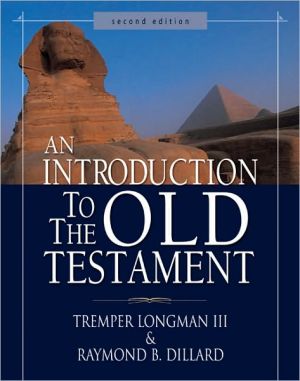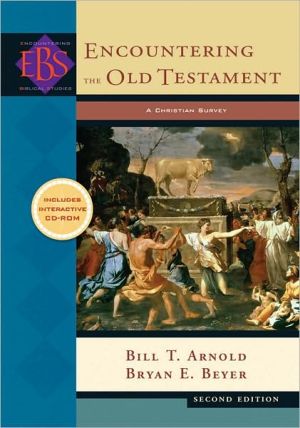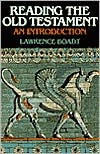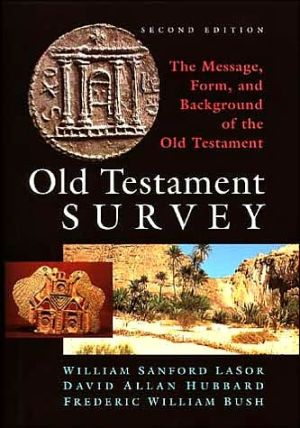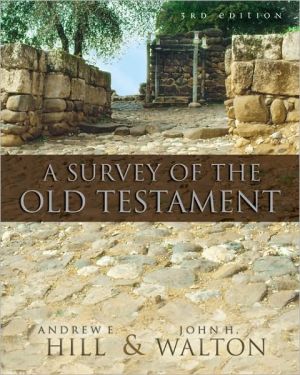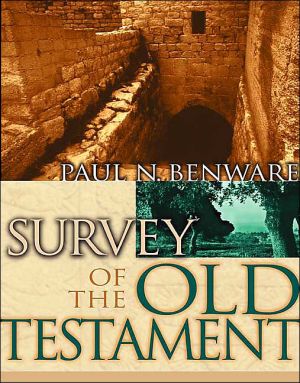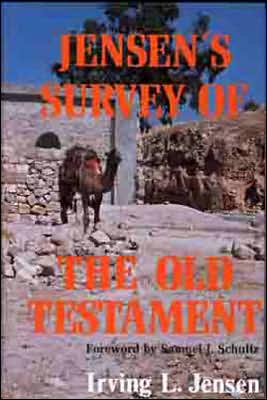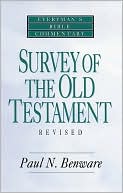An Introduction to the Old Testament
This second edition of An Introduction to the Old Testament integrates and interacts with recent developments in Old Testament scholarship. Several distinctive set it apart from other introductions to the Old Testament:\ * It is thoroughly evangelical in its perspective\ * It emphasizes 'special introduction'---the study of individual books\ * It interacts in an irenic spirit with the historical-critical method\ * It features points of research history and representative scholars rather than...
Search in google:
This second edition of An Introduction to the Old Testament has been revised and updated to reflect recent advances in Old Testament scholarship. An upper-level introduction that includes callouts, charts, and graphs, it offers a solid understanding of three key issues: historical background, literary analysis, and theological message.
An Introduction to the Old Testament\ \ By Tremper Longman Raymond B. Dillard \ ZONDERVAN\ Copyright © 2006 Tremper Longman III and Raymond B. Dillard\ All right reserved.\ ISBN: 978-0-310-26341-8 \ \ \ Chapter One\ Genesis \ The opening book of the Bible appropriately begins with the phrase "In the beginning." This phrase (Heb. bereît) is also used as the title of the book in Jewish tradition. Indeed, it is a book of beginnings, or "origins" as its English title, Genesis (derived from the Septuagint [Gen. 2:4a is its likely source]), suggests. Although infrequently cited elsewhere, the book is foundational to the rest of the Torah (the first five books of the Bible), to the Old Testament, and even to the New Testament.\ These five books of the Torah share a unity of history, plot, and theme that draws them together, as does their traditional ascription to a single author— Moses (see below).Thus it will be impossible to completely isolate Genesis from the other four books in the following discussion of authorship, style, and theological message.\ Genesis covers an immensely long period of time, longer perhaps than the rest of the Bible put together. It begins in the distant past of creation, an event about whose absolute date we cannot even speculate, through millennia to reach Abraham at the end of chapter 11. At this point the story line slows down and focuses on four generations of the family of promise as they move from Mesopotamia to the land of promise, only to conclude the book in Egypt. Thus we have a book of foundations that spans a time period of unknown duration and follows the people of God as they travel from one end of the Near East to the other.\ BIBLIOGRAPHY\ Commentaries\ G. C. Aalders, Genesis (BSC; Zondervan, 1981); W. Brueggemann, Genesis (Interp; John Knox; 1982); U. Cassuto, Commentary on Genesis, 2 vols., trans. I. Abrahams (Jerusalem: Magnes, 1964); G. W. Coats, Genesis with an Introduction to Narrative Literature (FOTL 1; Eerdmans, 1983); V. Hamilton, Genesis 1–17 (NICOT; Eerdmans, 1990); idem, Genesis 18–50 (NICOT; Eerdmans, 1995); J. E. Hartley, Genesis (Hendrikson, 2000); D. Kidner, Genesis (TOTC; InterVarsity Press, 1967); K. A. Matthews, Genesis 1:1–11:26 (NAC; Broadman, 1996); R. W. Moberley, The Old Testament of the Old Testament: Patriarchal Narratives and Mosaic Yahwism (Fortress, 1992); M. Noth, Exodus (Westminster, 1962); O. P. Robertson, Christ of the Covenants (Baker, 1980); J. H. Sailhamer, "Genesis" (EBC, Zondervan, 1990); N. M. Sarna, Genesis (JPS Torah Commentary; Jewish Publication Society, 1989); J. Skinner, Genesis (ICC; T. & T. Clark, 1910); E. A. Speiser, Genesis (AB 1; Doubleday, 1964); G. von Rad, Genesis (OTL; Westminster, 1961); B. K. Waltke, Genesis (Zondervan, 2001); J. H. Walton, Genesis (NIVAC; Zondervan, 2001); G. J. Wenham, Genesis 1–15 (WBC 1; Word, 1987); idem, Genesis 16–50 (WBC; Word, 1994); C. Westermann, Genesis: A Commentary, trans. J. J. Scullian (Augsburg, 1984–86).\ Monographs and Articles\ T. D. Alexander, Abraham in the Negev: A Source-Critical Study of Genesis 20:1– 22:19 (Paternoster, 1997); O. T. Allis, The Five Books of Moses (Presbyterian and Reformed, 1943); R. Alter, The Art of Biblical Narrative (Basic Books, 1981); idem, "Harold Bloom's 'J'," Commentary 90 (1990), 28–33; J. Barton, Reading the Old Testament (Westminster, 1984); H. Blocher, In the Beginning: The Opening Chapters of Genesis (InterVarsity Press, 1984); H. Bloom, (with D. Rosenberg), The Book of J (Grove Weidenfeld, 1990); P. Borgman, Genesis: The Story We Haven't Heard (InterVarsity Press, 2001); D. M. Carr, Reading the Fractures of Genesis: Historical and Literary Approaches (Westminster John Knox, 1996); U. Cassuto, The Documentary Hypothesis, trans. I. Abrahams (Jerusalem: Magnes, 1961 [Heb. ed., 1941]); B. S. Childs, Introduction to the Old Testament as Scripture (IOTS; Fortress, 1979); D. L. Christiansen and M. Narucki, "The Mosaic Authorship of the Pentateuch," JETS 32 (1989): 465–72; D. J. Clines, The Theme of the Pentateuch (Sheffield, 1978); T. B. Dozeman, God on the Mountain (SBLMS; Missoula: Scholars, 1989); B. Eichler, "Nuzi and the Bible: A Retrospective," in DUMU-E-DUBBA-A: Studies in Honor of Ake W. Sjoberg, ed. H. Behrens et al. (Samuel Noah Kramer Fund, 1989), 107–19; J. A. Emerton, "An Examination of Some Attempts to Defend the Unity of the Flood Narrative, Part II," VT 38 (1988): 1–21; J. P. Fokkelman, Narrative Art in Genesis (Assen and Amsterdam, 1975); R. E. Friedman, The Bible with Sources Revealed (Harper SanFrancisco, 2003); W. R. Garr, In His Own Image and Likeness (E. J. Brill, 2003); D. Garrett, Rethinking Genesis: The Sources and Authorship of the First Book of the Bible (Mentor, 2003); J. Goldingay, Old Testament Theology: Israel's Gospel (InterVarsity Press, 2003); J. Hoffmeier, Israel in Egypt (Oxford, 1997); I. M. Kikawada and A. Quinn, Before Abraham Was: The Unity of Genesis 1–11 (Abingdon, 1985); K. A. Kitchen, Ancient Orient and Old Testament (InterVarsity Press, 1967); idem, The Bible in Its World (InterVarsity Press, 1978); H.-J. Kraus, Geschichte der historisch-kritischen Erforschung des Alten Testaments (Neukirchen-Vluyn, 1956); J. D. Levenson, Creation and the Persistence of Evil (Princeton University Press, 1988); T. Longman III, "Form Criticism, Recent Developments in Genre Theory, and the Evangelical," WTJ 48 (1985): 46–67; idem, How to Read Genesis (InterVarsity Press, 2005); A. A. MacRae, "Response" in Hermeneutics, Inerrancy, and the Bible, ed. E. D. Radmacher and R. D. Preus (Zondervan, 1984), 143–62; J. G. McConville, Law and Theology in Deuteronomy (JSOTS 33; Sheffield: JSOT, 1984); S. E. McEvenue, The Narrative Style of the Priestly Writer (Rome: Biblical Institute Press, 1971); A. R. Millard and D. J. Wiseman, eds. Essays on the Patriarchal Narratives (InterVarsity Press, 1980); I. Provan, V. P. Long, and T. Longman III, A Biblical History of Israel (Westminster John Knox, 2003); R. Rendtorff, Die überlieferungsgeschichtliche Problem des Pentateuch (1977); J. W. Rogerson, Old Testament Criticism in the Nineteenth Century: England and Germany (Fortress, 1985); A. P. Ross, Creation and Blessing: A Guide to the Study and Exposition of Genesis (Baker, 1988); W. H. Schmidt, "Playdoyer für die Quellenscheidung," BZ 32 (1988): 1–14; M. Selman, "Comparative Customs and the Patriarchal Age," in Essays on the Patriarchal Narratives, ed. A. Millard and D. J. Wiseman (InterVarsity Press, 1980), 91–140; J. A. Soggin, Introduction to the Old Testament (IOT, Westminster John Knox, 3rd ed., 1989); R. J. Thompson, Moses and the Law in a Century of Criticism Since Graf (Leiden: Brill, 1970); T. L. Thompson, The Historicity of the Patriarch Narratives (BZAW 133; 1974); J. H. Tigay, The Evolution of the Gilgamesh Epic (University of Pennsylvania Press, 1982); L. A. Turner, "Book of Genesis," DOTP (InterVarsity Press, 2003), 350–59; J. Van Seters, Abraham in History and Tradition (Yale University Press, 1975); idem, Prologue to History: The Yahwist as Historian in Genesis (Westminster John Knox, 1992); B. K. Waltke, "Historical Grammatical Problems," in Hermeneutics, Inerrancy, and the Bible, ed. E. D. Radmacher and R. D. Preus (Zondervan, 1984), 69–130; G. J. Wenham, "The Date of Deuteronomy: Linchpin of Old Testament Criticism: Part II," Themelios 11 (1985): 15–17; idem, "Genesis: An Authorship Study and Current Pentateuchal Criticism," JSOT 42 (1988): 3–18; idem, Story as Torah: Reading the Old Testament Ethically (Baker, 2004); R. N. Whybray, The Making of the Pentateuch: A Methodological Study (JSOTS 53; Sheffield: JSOT, 1987); M. J. Williams, Deception in Genesis: An Investigation into the Morality of a Unique Biblical Phenomenon (Peter Lang, 2001).\ HISTORICAL BACKGROUND\ Composition and Authorship\ The issue of the authorship of Genesis is inescapably intertwined with the question of the composition and origin of the entire Pentateuch. Thus this section on authorship will be longer than those found in other chapters, but it will serve as the basis for the following chapters. Even so, this subject needs fuller treatment, and for this reason special attention will be given to secondary literature.\ This issue is one that has severely divided conservative scholars from others. The focus of debate, to be defined below, is Mosaic authorship. Debate may be too strong a word, though, since nonconservative scholars quietly ignore those who still defend a traditional viewpoint on authorship (Eissfeldt, OTI, 166). In fairness, it must also be said that conservative Christians have been too quick to distance themselves from the possibility of sources and too closed to any evidence of significant post-Mosaic activity. The sharp division between conservatives and others has recently been softened by a stronger emphasis on the thematic unity of the Pentateuch by critics, while conservatives have been less hesitant to speak of sources (e.g., Ross;Wenham). Nonetheless, because of the nature and importance of the issue, we will describe both the traditional conservative and the critical positions, attempt to capture the present state of the discussion, and draw some final conclusions.\ Text and Tradition\ In a strict sense, the Torah is anonymous. Nowhere do these five books explicitly or implicitly claim that Moses is their exclusive author (Aalders 1981, 5). On the other hand, early Jewish and Christian tradition (see Harrison, IOT, 497, who cites Ecclesiasticus 24:23, Philo, Josephus, the Mishnah, and the Talmud) is virtually unanimous in ascribing Genesis through Deuteronomy to him. On what grounds?\ Although a connection is never specifically made between Moses and the present Torah (in the Torah), there are a number of references to his writing activity (Allis 1943, 1–18). God commands him to record certain historical events (Ex. 17:14; Num. 33:2) and laws (Ex. 24:4; 34:27) as well as a song (Deut. 31:22; see Deut. 32).While Moses is not identified as the author of much of the Torah, the text does witness to the fact that he was the recipient of revelation and a witness to redemptive acts.\ According to later biblical testimony, there was a book of the Law that was associated with Moses' name (Josh. 1:7, 8). Late in the history of Israel, the Israelites could refer to a "Book of Moses" (2 Chron. 25:4; Ezra 6:18; Neh. 13:1). These passages provide strong intrabiblical data for a Mosaic writing, while not being specific about its shape or scope. It is also clear that Jesus and the early church connected much, if not all, of the Torah with Moses (Matt. 19:7; 22:24; Mark 7:10; 12:26; John 1:17; 5:46; 7:23).\ This evidence has led to the belief that Moses wrote the Torah. Nonetheless, this statement is always qualified by the admission that certain passages were added after Moses' death. The most obvious of these so-called post-Mosaica is Deuteronomy 34, the narrative of the death of Moses. Although even this chapter has been attributed to Moses by some, most conservatives argue that it was a later addition, possibly added by Joshua (Archer, SOTI, 83), though more probably at a later date. Other passages that show indication of post-Mosaic origins include Genesis 11:31, which associates Abraham's Ur with the Chaldeans (a tribe that dominated southern Mesopotamia in the first millennium), and Genesis 14:14, which mentions Dan, an ancient city known by this name only much later (see also Gen. 32:32; 35:31; 40:15; Deut. 3:14; 34:1, 6, 10). Besides these and other passages that were most likely written after the death of Moses, there are also passages that are awkward if they are ascribed to Moses (the so-called a-Mosaica). For instance, Numbers 12:3 refers to Moses as the most humble man who ever lived, scarcely a statement the world's most humble man would make about himself.\ Thus the conservative view has always been qualified, however subtly, by admitting non-Mosaic elements to the Torah. While in the minds of most, these non-Mosaic parts are few and far between, it does indicate that to speak of Moses as author of the Pentateuch is not the same as saying that every word is the result of his work. Since there are what appear to be obvious later additions, many conservatives speak in terms of the "essential authorship" of Moses. This expression vigorously affirms Moses as the author of the Torah, while also leaving open the possibility of later canonical additions. Indeed, the post- and a-Mosaica could be just the tip of a large iceberg. There could be considerable later redactional activity that could extend to the latest period of Old Testament history.\ Along with this, it must also be admitted that sources have been used in the composition of the Torah. The sources are rarely explicitly cited (see Num. 21:14, the "Book of the Wars of the LORD," which was likely a post-conquest document, and Exodus 24:7, "the Book of the Covenant"). In addition, the Toledoth formula may indicate widespread use of sources in the book of Genesis (see discussion under Structure). Neither the biblical text nor the traditional doctrine of Scripture are contradicted by a widespread use of sources on the part of the biblical author.\ Historical-Critical Approaches\ Space will permit only the most general description of the historical-critical approach to the question of the composition of the Pentateuch. Detailed treatments of the development of the method and its conclusions are available in Kraus, Rogerson, and R. J. Thompson.\ (Continues...)\ \ \ \ \ Excerpted from An Introduction to the Old Testament by Tremper Longman Raymond B. Dillard Copyright © 2006 by Tremper Longman III and Raymond B. Dillard. Excerpted by permission of ZONDERVAN. All rights reserved. No part of this excerpt may be reproduced or reprinted without permission in writing from the publisher.\ Excerpts are provided by Dial-A-Book Inc. solely for the personal use of visitors to this web site. \ \
Contents\ Preface to the Second Edition....................7\ Abbreviations....................9\ 1. Introduction....................13\ 2. Genesis....................38\ 3. Exodus....................63\ 4. Leviticus....................81\ 5. Numbers....................92\ 6. Deuteronomy....................102\ 7. Joshua....................120\ 8. Judges....................133\ 9. Ruth....................144\ 10. Samuel....................151\ 11. Kings....................167\ 12. Chronicles....................190\ 13. Ezra-Nehemiah....................202\ 14. Esther....................213\ 15. Job....................224\ 16. Psalms....................237\ 17. Proverbs....................265\ 18. Ecclesiastes....................278\ 19. Song of Songs....................289\ 20. Isaiah....................301\ 21. Jeremiah....................321\ 22. Lamentations....................342\ 23. Ezekiel....................354\ 24. Daniel....................371\ 25. Hosea....................397\ 26. Joel....................409\ 27. Amos....................420\ 28. Obadiah....................435\ 29. Jonah....................443\ 30. Micah....................449\ 31. Nahum....................456\ 32. Habakkuk....................463\ 33. Zephaniah....................470\ 34. Haggai....................477\ 35. Zechariah....................484\ 36. Malachi....................496\ Scripture Index....................503\ Name Index....................520\ Subject Index....................526
